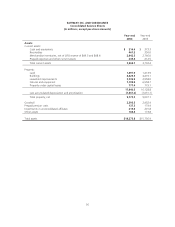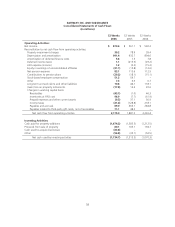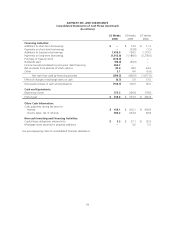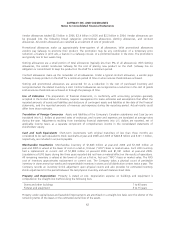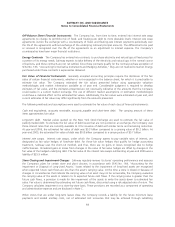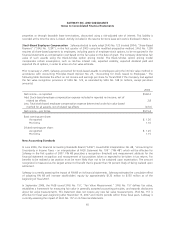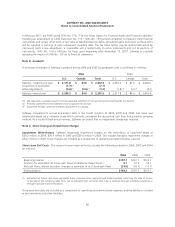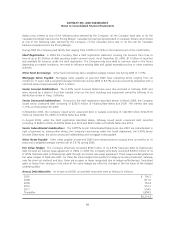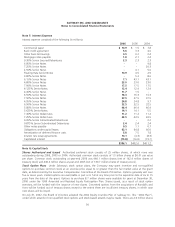Safeway 2006 Annual Report Download - page 60
Download and view the complete annual report
Please find page 60 of the 2006 Safeway annual report below. You can navigate through the pages in the report by either clicking on the pages listed below, or by using the keyword search tool below to find specific information within the annual report.
SAFEWAY INC. AND SUBSIDIARIES
Notes to Consolidated Financial Statements
Vendor allowances totaled $2.5 billion in 2006, $2.4 billion in 2005 and $2.2 billion in 2004. Vendor allowances can
be grouped into the following broad categories: promotional allowances, slotting allowances, and contract
allowances. All vendor allowances are classified as an element of cost of goods sold.
Promotional allowances make up approximately three-quarters of all allowances. With promotional allowances
vendors pay Safeway to promote their product. The promotion may be any combination of a temporary price
reduction, a feature in print ads, a feature in a Safeway circular, or a preferred location in the store. The promotions
are typically one to two weeks long.
Slotting allowances are a small portion of total allowances (typically less than 5% of all allowances). With slotting
allowances, the vendor reimburses Safeway for the cost of placing new product on the shelf. Safeway has no
obligation or commitment to keep the product on the shelf for a minimum period.
Contract allowances make up the remainder of all allowances. Under a typical contract allowance, a vendor pays
Safeway to keep product on the shelf for a minimum period of time or when volume thresholds are achieved.
Slotting and promotional allowances are accounted for as a reduction in the cost of purchased inventory and
recognized when the related inventory is sold. Contract allowances are recognized as a reduction in the cost of goods
sold as volume thresholds are achieved or through the passage of time.
Use of Estimates The preparation of financial statements, in conformity with accounting principles generally
accepted in the United States of America, requires management to make estimates and assumptions that affect the
reported amounts of assets and liabilities and disclosure of contingent assets and liabilities at the date of the financial
statements, and the reported amounts of revenues and expenses during the reporting period. Actual results could
differ from those estimates.
Translation of Foreign Currencies Assets and liabilities of the Company’s Canadian subsidiaries and Casa Ley are
translated into U.S. dollars at year-end rates of exchange, and income and expenses are translated at average rates
during the year. Adjustments resulting from translating financial statements into U.S. dollars are reported, net of
applicable income taxes, as a separate component of comprehensive income in the consolidated statements of
stockholders’ equity.
Cash and Cash Equivalents Short-term investments with original maturities of less than three months are
considered to be cash equivalents. Book overdrafts at year-end 2006 and 2005 of $243.8 million and $121.1 million,
respectively, are included in accounts payable.
Merchandise Inventories Merchandise inventory of $1,843 million at year-end 2006 and $1,943 million at
year-end 2005 is valued at the lower of cost on a last-in, first-out (“LIFO”) basis or market value. Such LIFO inventory
had a replacement or current cost of $1,892 million at year-end 2006 and $1,991 million at year-end 2005.
Liquidations of LIFO layers during the three years reported did not have a material effect on the results of operations.
All remaining inventory is valued at the lower of cost on a first-in, first-out (“FIFO”) basis or market value. The FIFO
cost of inventory approximates replacement or current cost. The Company takes a physical count of perishable
inventory in stores every four weeks and nonperishable inventory in stores and all distribution centers twice a year. The
Company records an inventory shrink adjustment upon physical counts and also provides for estimated inventory
shrink adjustments for the period between the last physical inventory and each balance sheet date.
Property and Depreciation Property is stated at cost. Depreciation expense on buildings and equipment is
computed on the straight-line method using the following lives:
Stores and other buildings 7 to 40 years
Fixtures and equipment 3 to 15 years
Property under capital leases and leasehold improvements are amortized on a straight-line basis over the shorter of the
remaining terms of the leases or the estimated useful lives of the assets.
42






